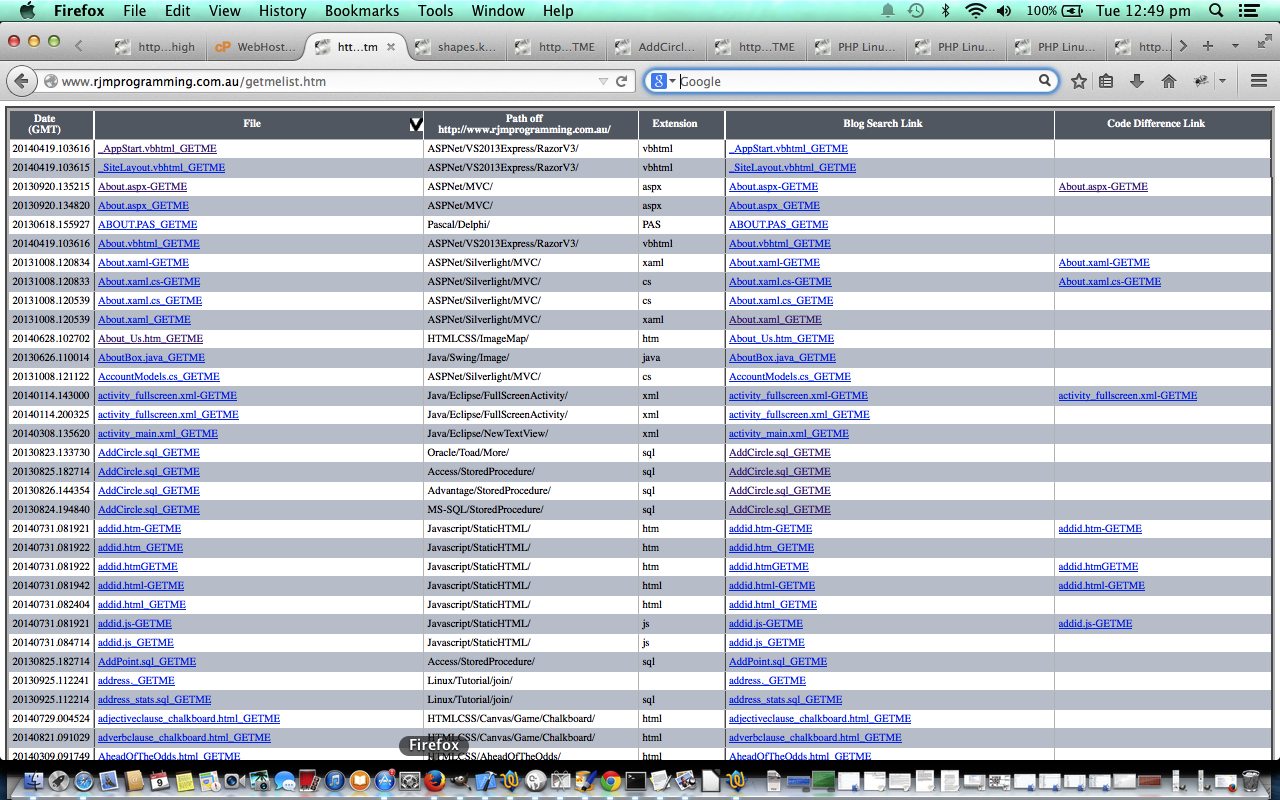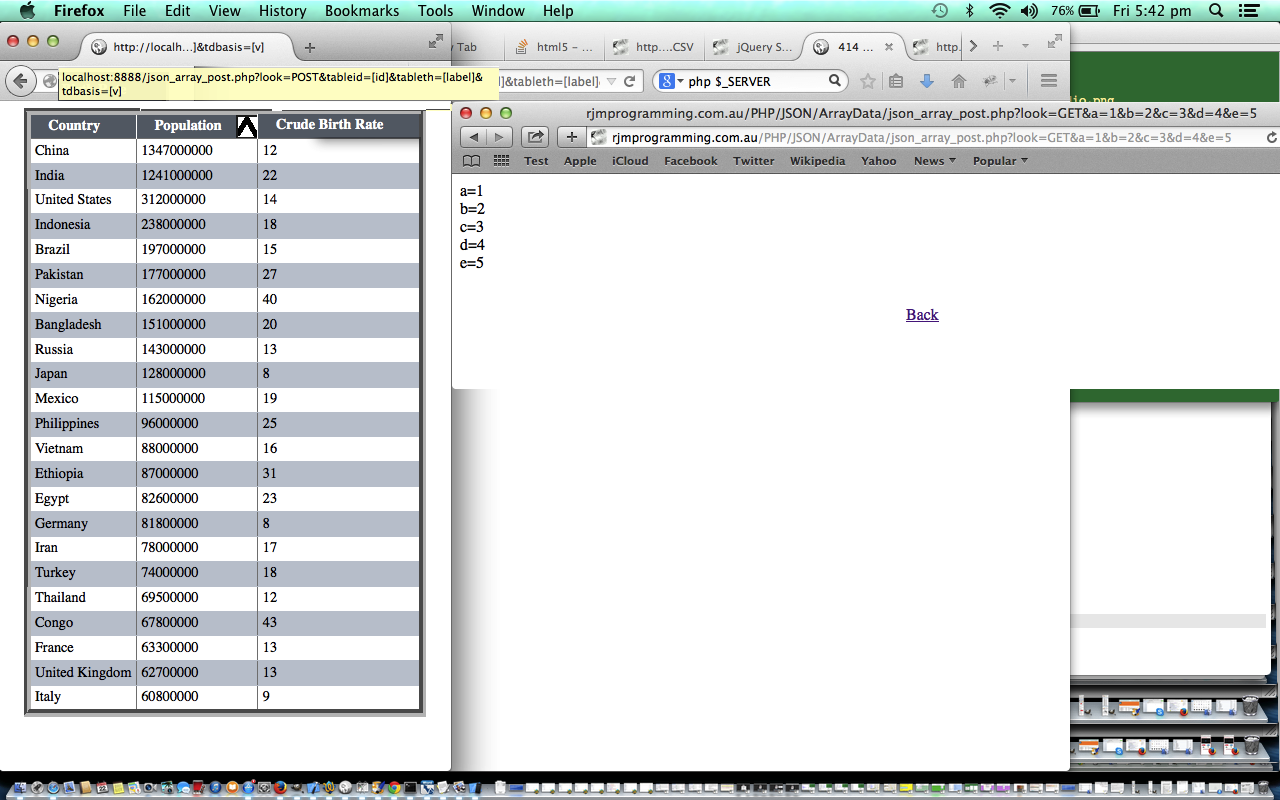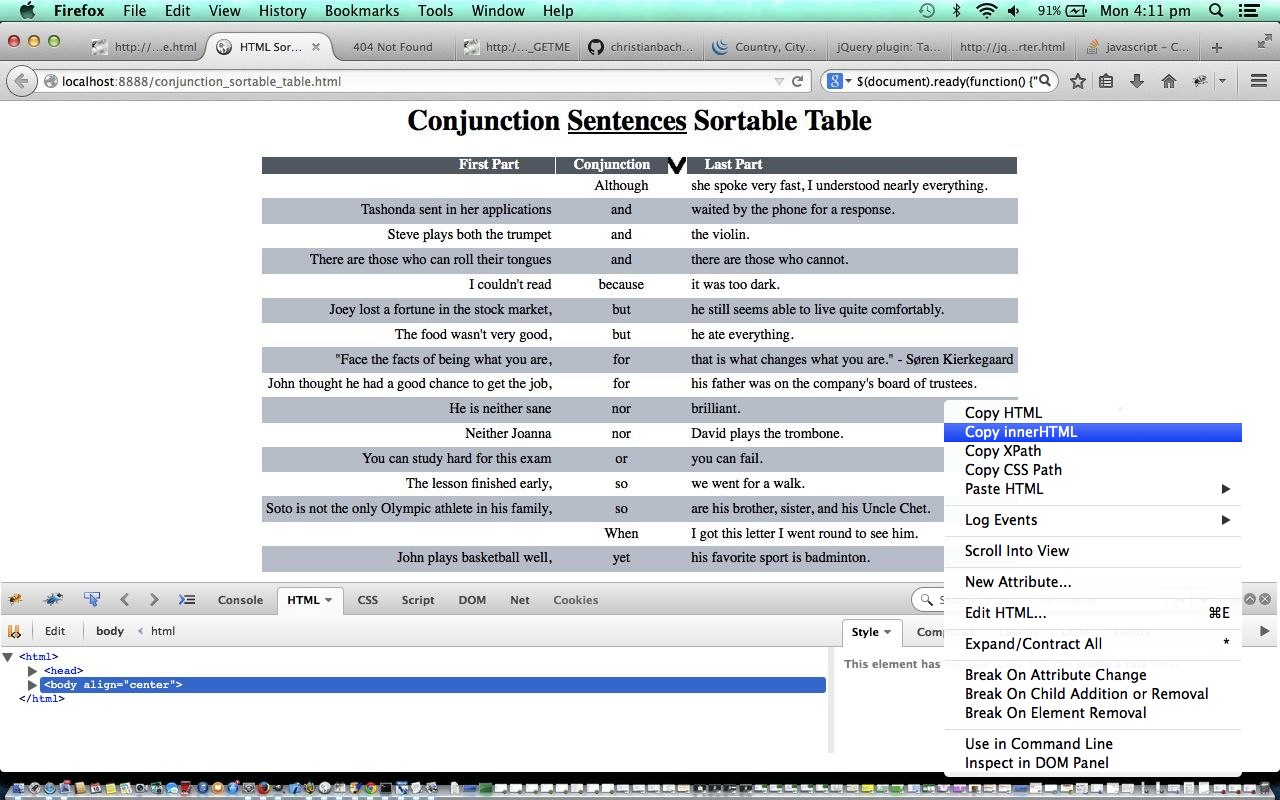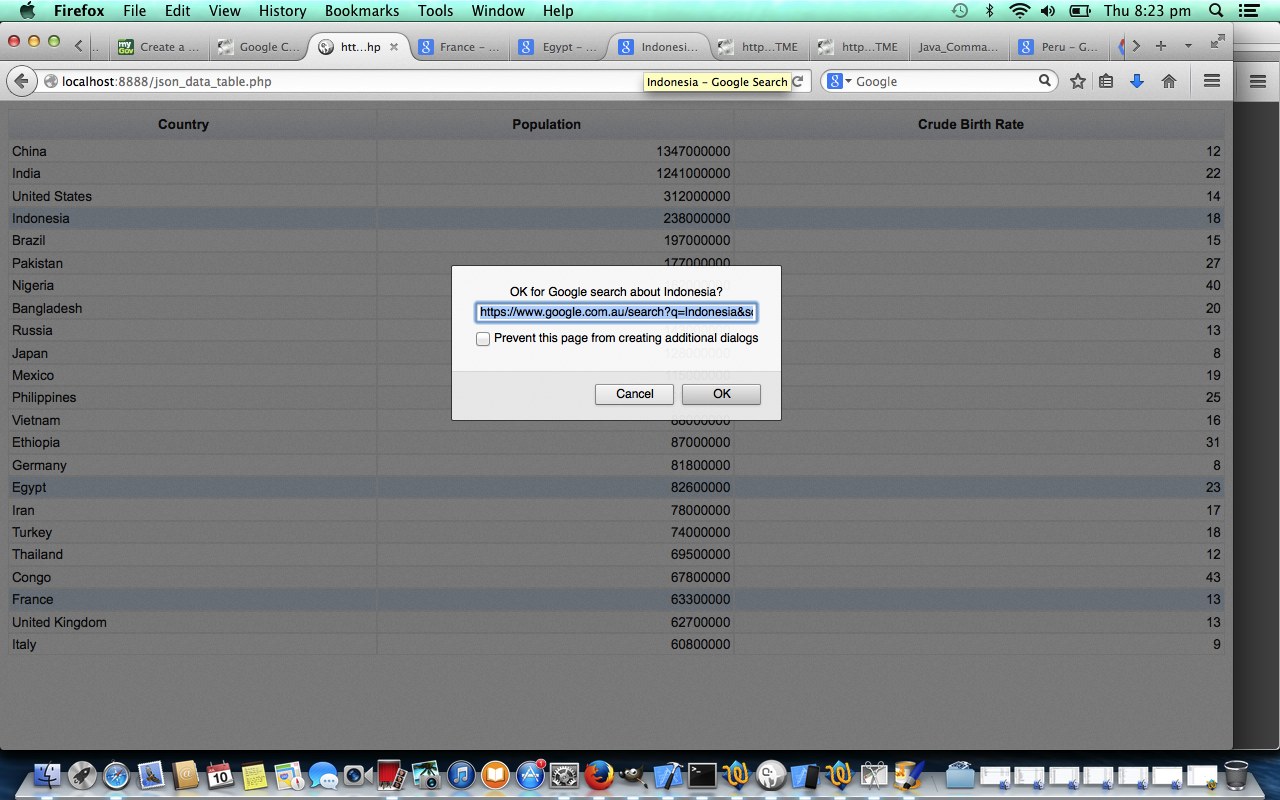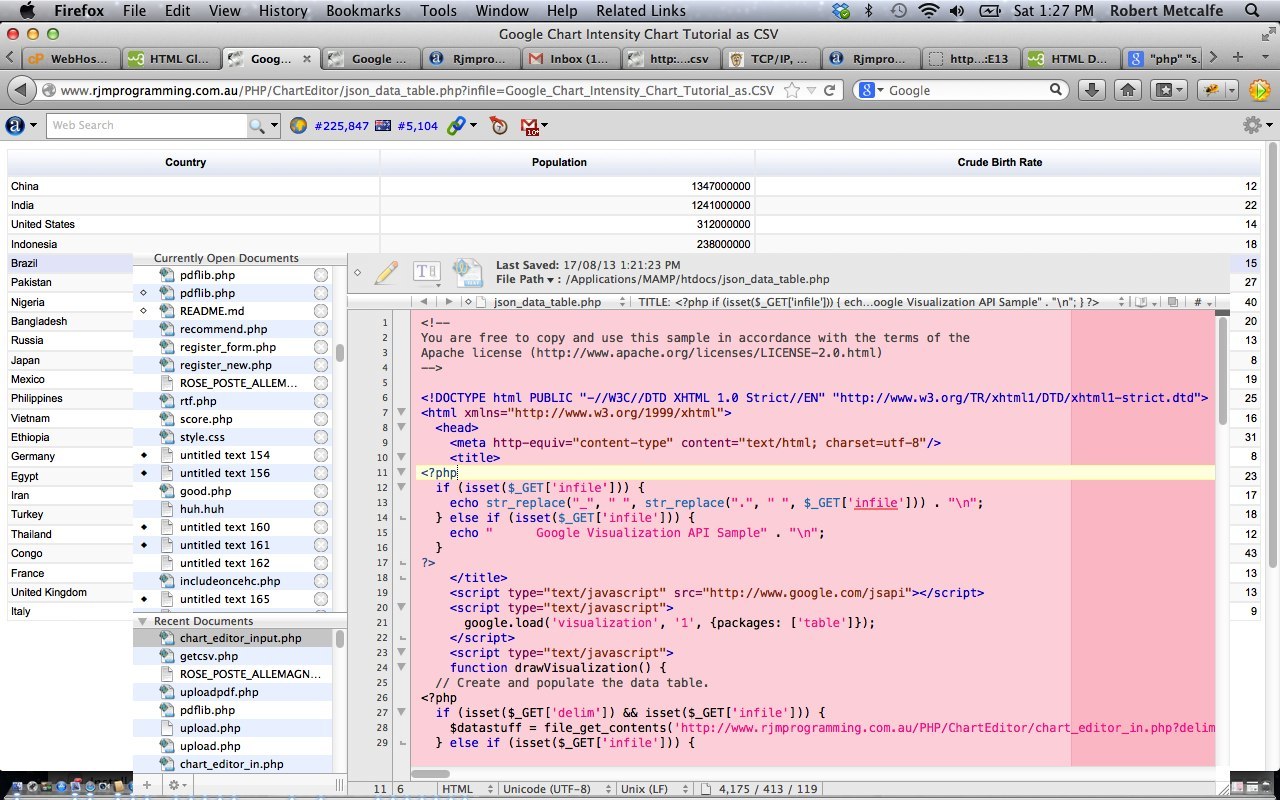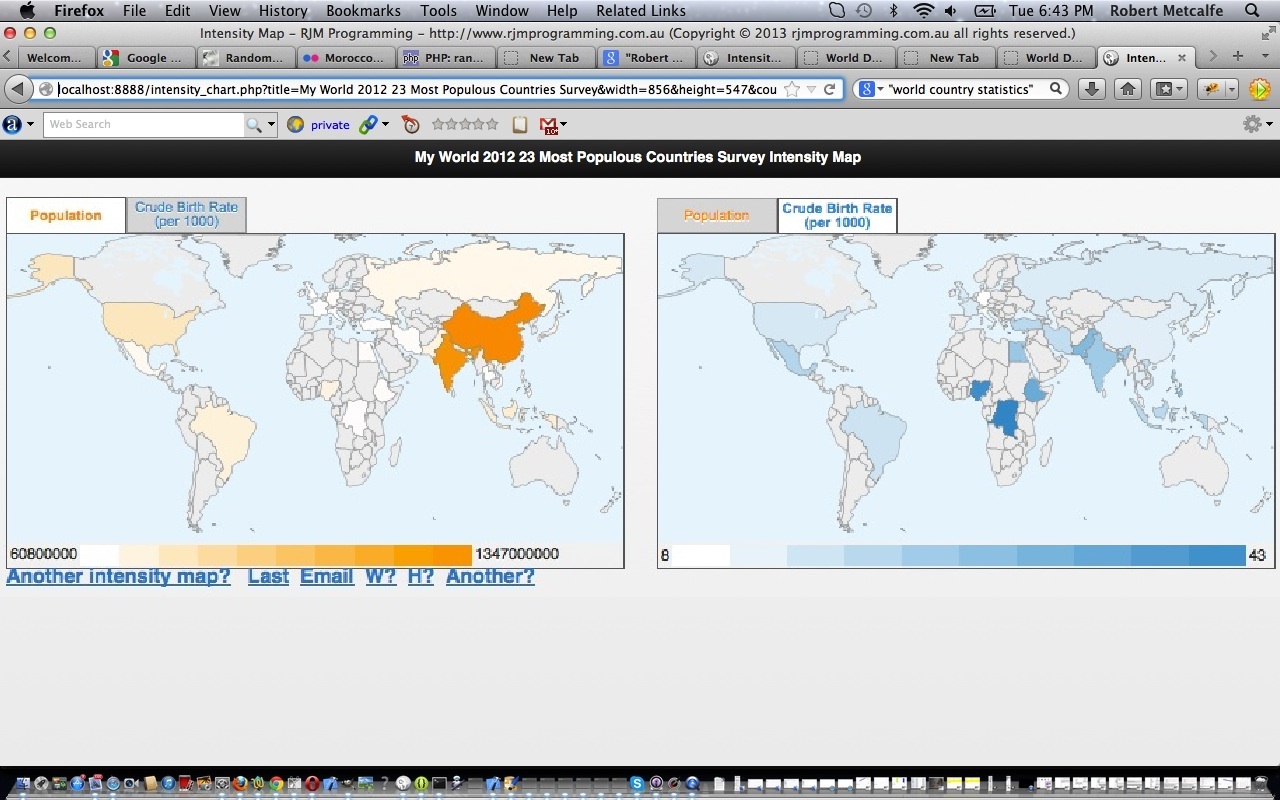There are two things that often happen for programmers:
- they break a job into its components (often immediately jumping to list the biggest “worry”)
- they look for ways to achieve the job faster and more reliably (ideas regarding code reuse both internally or externally)
With this in mind today’s job, which is a GETME code lister for this blog (like a blog summary (updated every day, via cron/curl)) had (or I wanted):
- sortable HTML tables
- data from Linux operating system
To me the biggest “worry” with this job is the “sortable HTML tables” (spend far more time on client side work (“front end”) per unit of time of productivity than server-side work (“back end”)). So, how about we start with a good code basis of “sortable HTML tables” … that’s why we’re showing you the PHP/Javascript JSON Feed or Array Data Primer Tutorial below that we are. Although it looks off-topic, it is very close code-wise, and this leads to another quality (or not) you may want, or not, to do with programming:
- do you mind the old
if (1 == 1) { }(for code you show to be “back in favour”) vsif (7 != 7) { }orif (("to be" || "not to be") == "that is the question") { }perhaps (for code that is “deliberately out of favour, but may be of interest, or come back into play later”) ? … lots of programmers will not like this, some will be fine with this … am in the latter group, because, to me, it is like “the comment you make when you’re not making a comment”
Back to the idea … we do a lot of code download offers with *GETME files here at this blog … so why not summarize all this in a sortable table?
Link to some downloadable PHP programming code … rename to getmelist.php as you wish and here is a link to the live run and will leave you with the difference in code between this idea and the one of the code below with getmelist.php.
Previous code-relevant tutorial called PHP/Javascript JSON Feed or Array Data Primer Tutorial is shown below.
JSON is a very useful protocol because:
- There is a lot of support in Javascript and the server-side languages, such as PHP or ASP.Net, for JSON-friendly functionality.
- Many website feeds use JSON as their protocol (format) of choice.
Today‘s live run is a simple interface to JSON incoming data and its presentation back to you, either as an HTML table element, or as a validator. Of interest, are the two previous tutorials below. We use an optional method of the first, and the same default input data (via Google Charts) as the second:
- jQuery Sortable Table Primer Tutorial
- PHP/Javascript/HTML Google Chart JSON Data Table Event Tutorial
Along the way, wanted to point out use of:
- Format of JSON data regarding array data … eg.
'{"a":1,"b":2,"c":3,"d":4,"e":5}' - PHP json_decode() method
- PHP http_build_query() method
- PHP urldecode() method
- Use of an HTML onload Javascript click of an HTML form’s submit button to automate the use of posted data … why post rather than get? … two reasons:
- better security
- there are limits to the amount of get data applied to your address bar urls that comes into play with get scenarios, but not with post scenarios
- Usefulness of online resources such as the JSONLint validator
- The attempts at genericity in the interface by converting posted feed url data into an HTML table presentation (with sortable column data) via the recognition of search specifications for:
- table ID
- table heading data
- table cell data
Here is a download link for some PHP programming source code you could call json_array_post.php
Perhaps Ajax functionality with local JSON data sources is of interest to you, and if this is the case, have a peruse of Ajax Local JSON Primer Tutorial … anyway, hope something here is of interest to you.
Previous relevant jQuery Sortable Table Primer Tutorial is shown below.
A lot of the things people like about the Web are to do with JavaScript and client-side activities. Adding to that experience are Javascript libraries packed full of features. Probably the best known of these is jQuery.
Read more about the powerful jQuery Javascript library here (at its spiritual home) and here (at Wikipedia).
Regarding this topic I really like “JavaScript & Ajax” seventh edition by Tom Negrino and Dori Smith pages 437 to 441. The code in this book was followed with quite a few changes. Why change a good thing … welllllll, want to show you some concepts/ideas/buffoonery which we’d like to present in pointy form below (you thought we were going to say “above” didn’t you? … go on! … admit it):
- Can include “old style” Javascript “body onload” code within jQuery ready functionality (just checking … because, personally, feel shy about combining the two worlds, but there is nothing wrong doing this, as we do today) …
- Function onloading() which is “old style” Javascript is the first thing called from jQuery ready code … why?
- First off please refer to today’s downloadable HTML/Javascript/jQuery code you could call conjunction_sortable_table.html
- Sometimes you want to use Javascript DOM techniques to dynamically load your document.body.innerHTML contents … so that, perhaps, you can read off a data source of some kind … wouldn’t PHP be sooooo great here?! … Subtext translation: the programmer is lazy and wanted to save coding time by taking an array from the previous tutorial called HTML/Javascript Sentence Conjunction Game Tutorial
- The jQuery ready code fires at the webpage’s body onload event, and you lose the ability to go <body onload=’onloading();’> but this doesn’t stop you plugging in onloading() up the top of your ready code … are you still awake?!
- Alternative approach is static HTML, and this is presented to you, but is commented out down the bottom of our code provided today … by the way, HTML comment goes <!– … –>
- … and how was this derived when a View->Page Source doesn’t show it? …
- … use Firebug (or something like it) and point at the body tag and use “Copy innerHTML” to derive this (as per the tutorial’s picture)
- Use of cursor:pointer style property to make a span tag, within an h1 tag act like an a tag
- Recall of ready function for the addsome() Javascript bit awkward, in that code is repeated
- Maybe start reading http://stackoverflow.com/questions/999092/can-i-call-the-function-ready-again-in-jquery to see if you can do better
Click on picture above to go to jQuery page for a (live run) tutorial on the jQuery concept called Sortable Table.
Link to jQuery information … via Wikipedia.
Link to jQuery spiritual home page … via jQuery Foundation.
Link to the great third-party jQuery Sortable Table code is available from the GitHub source control resource here which is a link from here … thanks heaps … isn’t Open Source great?!
Did you know?
The tutorial picture today features the Firefox web browser and a very useful add-on called Firebug which you may want more information about here, which is commonly used to debug client-side Javascript and HTML. As for today’s usage, Firebug is also extremely useful in deconstructing how a web page was created. The other simple wonderful tool for this is the web browser’s equivalent menu command like View->Page Source (or sometimes equivalent of right-click Page Source). Firebug has a sister product called FirePHP which helps debug server-side PHP and Ajax work.
If this was interesting you may be interested in this too.
Previous relevant PHP/Javascript/HTML Google Chart JSON Data Table Event Tutorial is shown below.
Here is a tutorial that re-introduces you to Google Graphs API, or Google Chart Tools, and its JSON Data Table functionality which we talked about last time with PHP/Javascript/HTML Google Chart JSON Data Table Import of CSV Tutorial as shown below. Today we extend the functionality talk by adding some event logic for when we click on a table row.
Google Chart Tools provide a perfect way to visualize data on your website. From simple line charts to complex hierarchical tree maps, the chart galley provides a large number of well-designed chart types. Populating your data is easy using the provided client- and server-side tools.
Thanks to the World Bank for some statistics which helped a lot.
Let’s see some PHP code in live action for this tutorial where you see a JSON Data Table derived from a filename passed as a parameter in the URL. The data shown is based on a CSV file of a previous PHP/Javascript/HTML Google Chart Intensity Map Tutorial shown below.
Link to Google Chart Tools “spiritual home” … via Google.
Link to Google Chart Tools JSON Data Table information … via Google.
Link to Google Chart Tools Event information … via Google.
Link to some downloadable PHP programming code … rename to chart_editor_in.php.
Link to some downloadable PHP programming code … rename to json_data_table_events.php.
Link to some downloadable input CSV data … rename to Google_Chart_Intensity_Chart_Tutorial_as.CSV.
Here is the way we got from the tutorial logic below to this tutorial’s source code’s logic here.
Previous PHP/Javascript/HTML Google Chart JSON Data Table Import of CSV Tutorial is shown below.
Here is a tutorial that introduces you to Google Graphs API, or Google Chart Tools, and its JSON Data Table functionality.
Google Chart Tools provide a perfect way to visualize data on your website. From simple line charts to complex hierarchical tree maps, the chart galley provides a large number of well-designed chart types. Populating your data is easy using the provided client- and server-side tools.
Thanks to the World Bank for some statistics which helped a lot.
Let’s see some PHP code in live action for this tutorial where you see a JSON Data Table derived from a filename passed as a parameter in the URL. The data shown is based on a CSV file of a previous PHP/Javascript/HTML Google Chart Intensity Map Tutorial shown below.
Link to Google Chart Tools “spiritual home” … via Google.
Link to Google Chart Tools JSON Data Table information … via Google.
Link to some downloadable PHP programming code … rename to chart_editor_in.php.
Link to some downloadable PHP programming code … rename to json_data_table.php.
Link to some downloadable input CSV data … rename to Google_Chart_Intensity_Chart_Tutorial_as.CSV.
Previous PHP/Javascript/HTML Google Chart Intensity Map Tutorial below …
Here is a tutorial that introduces you to Google Graphs API, or Google Chart Tools, and its Intensity Map functionality.
Google Chart Tools provide a perfect way to visualize data on your website. From simple line charts to complex hierarchical tree maps, the chart galley provides a large number of well-designed chart types. Populating your data is easy using the provided client- and server-side tools.
Thanks to the World Bank for some statistics which helped a lot.
Let’s see some PHP code in live action for this tutorial where you define your intensity map characteristics and data.
Now part of an Android App called Geo Chart++ in July 2013.
Link to Google Chart Tools “spiritual home” … via Google.
Link to Google Chart Tools Intensity Map information … via Google.
Link to some downloadable PHP programming code … rename to intensity_chart.php.
If this was interesting you may be interested in this too.
If this was interesting you may be interested in this too.
If this was interesting you may be interested in this too.
If this was interesting you may be interested in this too.
If this was interesting you may be interested in this too.

